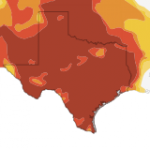Life By the Drop: High and Dry on the Highland Lakes
 Earlier this year, walking along the dry river and lake beds of the Highland Lakes, you’d likely find yourself stepping on gravel, fish bones and fresh-water clam shells. After the lakes sat around sixty percent drained, water wells in the area also began to fail. That happened most noticeably in Spicewood Beach, where the Lower Colorado River Authority (LCRA), the agency that owns the well, needed to haul water in by truck for the people who live there.
Earlier this year, walking along the dry river and lake beds of the Highland Lakes, you’d likely find yourself stepping on gravel, fish bones and fresh-water clam shells. After the lakes sat around sixty percent drained, water wells in the area also began to fail. That happened most noticeably in Spicewood Beach, where the Lower Colorado River Authority (LCRA), the agency that owns the well, needed to haul water in by truck for the people who live there.
In this installment of our series on water issues along the Colorado River, part of Life By the Drop: Drought, Water and the Future of Texas, we hear from two residents of Spicewood Beach at the start of the town’s water shortage.
As the LCRA hauls water into town and begins construction of a long-term water storage system, Robert Salinas and Martin Peterson speculate about what went wrong, and whether things will ever get better. The audio was produced by Mose Buchele and the slideshow by Filipa Rodrigues.
Since the well failed, little has changed in Spicewood Beach.
The LCRA is still trucking in water. And they’ve needed to increase the number of shipments to six-to eight times a day. The LCRA is also still planning on selling the Spicewood Beach water system to a Canadian company. They expect a deal will be finalized within the next few weeks.
LCRA spokesperson Clara Tuma says the well may recover. The water level in Lake Travis currently sits around 641 feet above sea level. “Our prediction is that when the lake gets to 645 [feet above sea level],” Tuma says, “we should see an increase in what the wells are able to produce.”

